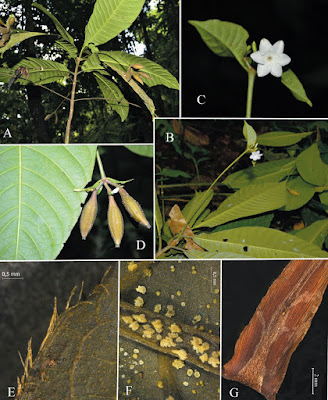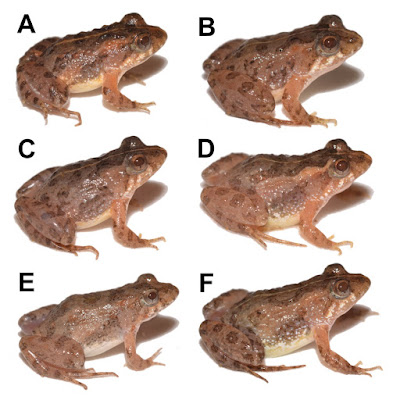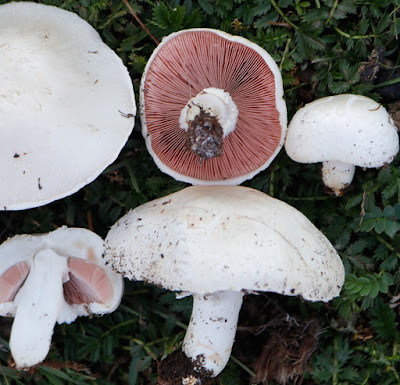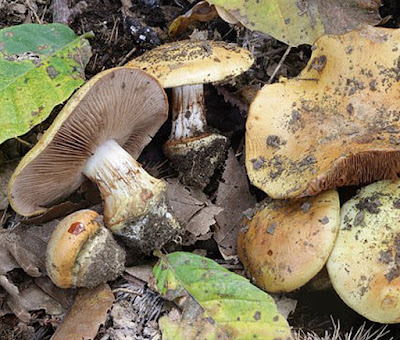[Most Recent Entries] [Calendar View]
Thursday, July 9th, 2020
| Time | Event | ||||||
| 1:53a | [Botany • 2020] Lintersemina chucuriensis (Rubiaceae: Condamineeae) • A New and Enigmatic Genus from the Magdalena Medio Region of Colombia
Abstract A new genus, Lintersemina (Condamineeae, Rubiaceae), with a single species, L. chucuriensis is here described, based on recent collections made during a biological exploration to the Magdalena Medio Region of Santander Department, central portion of Colombia. This region is of high interest for both the high endemicity of its flora and fauna and the critical conservation status of this biodiversity due to high levels of deforestation. Lintersemina is unique within the tribe Condamineeae for the following combination of characters: axillary, long-pedunculate inflorescences, loculicidal capsules with 1-2 seeds per locule, and large navicular seeds. Based on phylogenies obtained using plastid and nuclear sequence data, the genus is positioned in the Condamineeae (subfamily Ixoroideae), as a sister group to the genera Simira and Parachimarrhis. This new genus is only known from two localities at the foothills of the Yariguíes National Park, in the municipalities of El Carmen de Chucurí and Zapatoca, at 400–800 m elevation, in forest undercanopy, near streams. Threats of deforestation and a very low population density were assessed, and this species classified as Critically Endangered (CR) following IUCN criteria. Full description and illustrations are also included. Keywords: Conservation, flora of Colombia, Santander, Tropical humid Forest, Eudicots Taxonomy Lintersemina H. Mendoza-Cifuentes & A. Celis & M.A. González, gen. nov. Type species:— Lintersemina chucuriensis H. Mendoza-Cifuentes, A. Celis & M.A. González Diagnosis:— This new genus is unique within the tribe Condamineeae by the following combination of characters: axillary, long-pedunculate inflorescences, ovary with 1–2 ovules per locule, loculicidal capsules, and large, terete, navicular (boat-shaped) seeds. Treelet. Leaves opposite, decussate, petiolate; petioles slightly thickened at the base; blade venation brochidodromous, with secondary veins ascending and arcuate. Stipules interpetiolar, readily caducous, only found at apical buds and youngest nodes, with colleters in adaxial surface, resinous. Inflorescences axillary, subterminal, corymbose cymes, pedunculate, many-flowered; with two types of bracts, the basal ones subtending the inflorescence leaf-like, the distal ones triangular. Flowers hermaphroditic, protandrous, 5- or 6-merous, actinomorphic, pedicellate, erect. Calyx persistent in fruit. Corolla aestivation left-contorted. Stamens included; anthers opening by longitudinal slits. Ovary 2-locular, placentation axile, ovules 1 or 2 in each locule; style included, with two stigmatic branches. Fruit a loculicidal capsule. Seeds >1 cm long, terete, navicular, with membranaceous structures along the raphe. A monospecific genus, endemic to Magdalena Medio Region of Colombia, growing in tropical rainforest. Etymology:— The name of this genus refers to its navicular (boat-shaped) seeds. Lintersemina chucuriensis H. Mendoza-Cifuentes, A. Celis & M.A. González, spec. nov. Habitat:— Lintersemina chucuriensis grows in shady undercanopy of tropical forest, near streams (Figure 7). Distribution:— Lintersemina chucuriensis is known from two localities in the Santander Department, Colombia, between 400 and 800 m elevation, in the lower part of the western foothills of the Cordillera Oriental, area associated with the ecoregion known as the Magdalena Medio (Figure 6). The forest at the site comprises the last remains of lowland inter-Andean rainforests in the Colombian Magdalena River valley region, and its condition consists of fragments in the matrix of paddocks and cocoa crops; most of the trees valuable for timber have been harvested (Figure 7). Humberto Mendoza-Cifuentes, Angela Celis, Eduardo Tovar, Mailyn A. González. 2020. Lintersemina (Rubiaceae: Condamineeae), A New and Enigmatic Genus from the Magdalena Medio Region of Colombia. Phytotaxa. 451(1); 1–20. DOI: 10.11646/phytotaxa.451.1.1 | ||||||
| 2:02a | [Herpetology • 2020] Pseudopaludicola coracoralinae • Reassessment of the Taxonomic Status of Pseudopaludicola parnaiba (Anura, Leptodactylidae, Leiuperinae), with the Description of A New Cryptic Species from the Brazilian Cerrado
Abstract The Neotropical frog genus Pseudopaludicola includes 25 species distributed throughout South America. Herein we review the taxonomic status of P. parnaiba relative to P. canga and the specific identity of the population treated in previous studies as Pseudopaludicola sp. 3 from Barreirinhas in the Brazilian state of Maranhão. The lack of differentiation in advertisement call, morphology, and mitochondrial markers from topotypes and different populations rejects the status of P. parnaiba and Pseudopaludicola sp. 3 from Barreirinhas as distinct species. For these reasons, we suggest to formally consider P. parnaiba as a junior synonym of P. canga. We also found that a population previously reported as P. facureae from central Brazil (Palmeiras de Goiás, Goiás) corresponds to a cryptic species that we describe here as a new species. Lastly, we provide for the first time the phylogenetic positions of P. giarettai, P. llanera and P. pusilla. Keywords: integrative taxonomy; Pseudopaludicola canga; mitochondrial DNA; morphologically cryptic species Class Amphibia Linnaeus, 1758 Order Anura Fischer von Waldheim, 1813 Family Leptodactylidae Werner, 1896 (1838) Subfamily Leiuperinae Bonaparte, 1850 Genus Pseudopaludicola Miranda-Ribeiro, 1926 Pseudopaludicola coracoralinae sp. nov. Pseudopaludicola facureae from Palmeiras de Goiás, GO — Carvalho et al. 2015a: 267, 271, table 4, appendix 1–2. Diagnosis: Pseudopaludicola coracoralinae sp. nov. is assigned to Pseudopaludicola by having a hypertrophied antebrachial tubercle (see Lynch 1989; Lobo 1995) and by its phylogenetic position within the genus. The new species is characterized by the following combination of characters: (1) upper eyelids smooth, without enlarged palpebral tubercles; (2) heel smooth, without conical tubercle; (3) single, subgular vocal sac, cream-colored with white or off-white warts; (4) terminal phalanges knobbed, without T-shaped terminal phalanges or expanded toe tips; (5) relative short hind limbs (tibio-tarsal articulation just reaching the corner of the mouth); (6) trilled advertisement call pattern, composed of 2–6 welldefined series of tonal notes, having each series of 7–116 notes, emitted at rates of 1485–2077 notes per minute. Etymology: The specific name honors Anna Lins dos Guimarães Peixoto Bretas, better known by her pseudonym Cora Coralina. She was a simple woman, a Brazilian candy maker, writer and poetess. She was born and raised on the banks of the Vermelho River, in the municipality of Goiás, GO, and lived apart from urban centers. Cora Coralina studied until the third year of elementary school and did a typing course at the age of 70, due to a requirement of the publisher that would publish her first book. She is considered one of the most influential Brazilian writers. Although Cora Coralina wrote her first verses during her adolescence, she had her first book (Poemas dos Becos de Goiás e Estórias Mais) published in June 1965, when she was 75 years old. In 1984, the Brazilian Union of Writers awarded her the “literary personality of the year”. Following that honor, Carlos Drummond de Andrade, another distinguished Brazilian poet, said: “I admire Cora Coralina and her mastery of living in a state of grace with her poetry. Her verse is like running waters, her lyricism has the power and delicacy of the natural world.” Felipe Silva de Andrade, Isabelle Aquemi Haga, Mariana Lúcio Lyra, Thiago Ribeiro de Carvalho, Célio Fernando Baptista Haddad, Ariovaldo Antonio Giaretta and Luís Felipe Toledo. 2020. Reassessment of the Taxonomic Status of Pseudopaludicola parnaiba (Anura, Leptodactylidae, Leiuperinae), with the Description of A New Cryptic Species from the Brazilian Cerrado. European Journal of Taxonomy. 679; 1-36. DOI: 10.5852/ejt.2020.679 | ||||||
| 4:20a | [Fungi • 2020] Species of Agaricus section Agaricus (Basidiomycota: Agaricomycetes) from China
Abstract Agaricus section Agaricus is generally recognized as a monophyletic group. In this study, 28 specimens of this section were collected from five provinces of China. Phylogenetic trees were produced based on the ITS sequences using Maximum Likelihood and Bayesian analyses. Based on this phylogenetic approach combined with their morphological examination, five species are identified including two new species named as A. jilinensis and A. zhangyensis, and three new recorded species from China, A. aristocratus, A. griseicephalus and A. argenteus. All species were described and illustrated in detail. Keywords: Agaricaceae, new species, morphology, phylogeny, ITS, Fungi An-Qi Liu, Rong-Chun Dai, Ming-Zhe Zhang, Bin Cao, Ya-Li Xi, Sheng-Long Wei and Rui-Lin Zhao. 2020. Species of Agaricus section Agaricus from China. Phytotaxa. 452(1); 1–18. DOI: 10.11646/phytotaxa.452.1.1 | ||||||
| 9:03a | [Fungi • 2020] Cortinarius lentus (Agaricales, Cortinariaceae) • A New Species in Section Calochroi
Abstract A new species of Cortinarius sect. Calochroi, Cortinarius lentus, is described on the basis of morphological and genetic features. It is characterised by a yellow-orange to brown-orange pileus, initially violaceous pink lamellae, a cream to pale yellow universal veil, amygdaliform to almost citriform spores, coarsely verrucose, typically narrow (Qav = 1.9) and habitat preference for chestnut woods on acidophilic soil. It is compared with the closest species from a morphological point of view, in particular with C. leochrous and C. calochrous. In order to assess its relative position within Calochroi, a phylogenetic approach based on RPB1 and ITS regions was performed. The ITS phylogenetic analysis did not resolve the position of C. lentus within sect Calochroi, but in our RPB1 phylogenetic analysis, C. sublilacinopes is closely related. Keywords: Agaricomycetes, Basidiomycota, Taxonomy, Mediterranean, Europe, Castanea sativa, Fungi Francesco Dovana, Fabrizio Boccardo, Marco Clericuzio and Alfredo Vizzini. 2020. Cortinarius lentus (Agaricales, Cortinariaceae), A New Species in Section Calochroi. Phytotaxa. 447(1); 31–41. DOI: 10.11646/phytotaxa.447.1.3 | ||||||
| 12:12p | [PaleoMammalogy • 2020] Norisdelphis annakaensis • A New Miocene Delphinid from Japan
ABSTRACT Two well-preserved delphinid crania have been recovered from the Haraichi Formation, Annaka Group, Gunma Prefecture, Japan (earliest late Miocene, Tortonian; 11.29–11.25 Ma). The specimens represent a new genus and species of delphinid, Norisdelphis annakaensis. The new species is characterized by transversely narrow and anteroposteriorly elongated external bony nares, and a wider proximal extremity of the left premaxilla. Phylogenetic analysis suggests that Norisdelphis is the most basal member of the Delphinidae. The previous oldest known described delphinid, Eodelphinus kabatensis, is from the upper Miocene (ca. 9 Ma), and other reliably dated and described fossil delphinids are no older than Pliocene; thus, N. annakaensis is the oldest convincingly dated and well-diagnosed fossil delphinid species yet described. Norisdelphis annakaensis expands the geological range of the family Delphinidae.
SYSTEMATIC PALEONTOLOGY Suborder ODONTOCETI Flower, 1867 Infraorder DELPHINIDA Muizon, 1984 Superfamily DELPHINOIDEA Gray, 1821 Family DELPHINIDAE Gray, 1821 NORISDELPHIS, gen. nov. Norisdelphis annakaensis, sp. nov. Etymology—From Greek, norís, meaning early, and delphis, dolphin. NORISDELPHIS ANNAKAENSIS, sp. nov. Etymology— Named for Annaka City, Gunma, Japan, where the holotype and the paratype were found.
Toshiyuki Kimura and Yoshikazu Hasegawa. 2020. Norisdelphis annakaensis, A New Miocene Delphinid from Japan. Journal of Vertebrate Paleontology. e1762628. DOI: 10.1080/02724634.2020.1762628 安中で発見のマイルカ科化石 1130万年前で世界最古&新種と認定 | ||||||
| 6:03p | [Paleontology • 2020] The First Juvenile Dromaeosaurid (Dinosauria: Theropoda) from Arctic Alaska
Abstract Compared to the osteological record of herbivorous dinosaurs from the Late Cretaceous Prince Creek Formation of northern Alaska, there are relatively fewer remains of theropods. The theropod record from this unit is mostly comprised of isolated teeth, and the only non-dental remains known can be attributed to the troodontid cf. Troodon and the tyrannosaurid Nanuqsaurus. Thus far, the presence of members of Dromaeosauridae has been limited to isolated teeth. Here we describe a symphyseal portion of a small dentary with two ziphodont teeth. Based on tooth shape, denticle morphology, and the position of the Meckelian groove, we attribute this partial dentary to a saurornitholestine dromaeosaurid. The fibrous bone surface, small size, and higher number of mesial denticles compared to distal ones point to a juvenile growth stage for this individual. Multivariate comparison of theropod teeth morphospace by means of principal component analysis reveals an overlap between this dentary and Saurornitholestinae dromaeosaurid morphospace, a result supported by phylogenetic analyses. This is the first confirmed non-dental fossil specimen from a member of Dromaeosauridae in the Arctic, expanding on the role of Beringia as a dispersal route for this clade between Asia and North America. Furthermore, the juvenile nature of this individual adds to a growing body of data that suggests Cretaceous Arctic dinosaurs of Alaska did not undergo long-distance migration, but rather they were year-round residents of these paleopolar latitudes. Dinosauria Theropoda Dromaeosauridae Eudromaeosauria Saurornitholestinae indet. Referred specimen: DMNH 21183. The anterior portion of a right dentary, preserving two teeth and four alveoli (Fig 3). Alfio Alessandro Chiarenza, Anthony R. Fiorillo, Ronald S. Tykoski, Paul J. McCarthy, Peter P. Flaig and Dori L. Contreras. 2020. The First Juvenile Dromaeosaurid (Dinosauria: Theropoda) from Arctic Alaska. PLoS ONE. 15(7): e0235078. DOI: 10.1371/journal.pone.0235078 |
| << Previous Day |
2020/07/09 [Calendar] |
Next Day >> |














